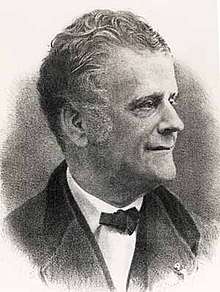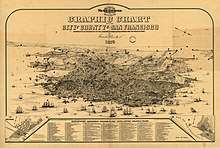Frederick Marriott
Frederick Marriott (16 July 1805, Enfield, England[2] – 16 December 1884, San Francisco, California) was an Anglo-American publisher and early promoter of aviation, creator of the Avitor Hermes Jr., the first unmanned aircraft to fly by its own power in the United States.
Frederick Marriott | |
|---|---|
 | |
| Born | July 16, 1805 Enfield, London, England |
| Died | December 16, 1884 (aged 72) San Francisco, California, United States |
His early years were influenced by his father William Marriott, a law agent and editor of the Taunton Courier. During his early 20s he was employed as a clerk in Bombay by the East India Company, returning to England in the early 1830s, where he married and accepted a position with the Bank of England.
The rapid expansion of the printing industry in Britain during the 1830s prompted Marriott to resign from the Bank of England and use a substantial portion of his wife's inheritance to fund a number of new publications. With the expanding readership of working class in England during the industrial revolution, the investments paid off; Marriott was involved in the creation of the Weekly Chronicle[3] and popular Illustrated London News.
In 1845 Marriott began publishing a weekly publication Chat, however by 1849 the venture failed, nearly bankrupting him. This lead ultimately to the dissolution of his marriage.
Rumours of gold in the American West prompted Marriott to pursue further adventure overseas; age 45 he sailed to California via the treacherous Isthmus of Panama and was nearly shipwrecked. Avoiding the temptation of the gold fields, Marriott became a banker in San Francisco. In 1856 he used his accumulated wealth to start a publication known as the Newsletter.[4]
He was described by the publisher of the newspaper Northern Indianian, 19 March 1874 as "an English gentlemen, of eccentric habits, much shrewdness and enterprise, and entire originality".
Marriott is credited with inventing the term "aeroplane", and intended to build an air transport system that would bring people from New York to California without the perils of the normal voyage of the 19th century. The company he formed (with Andrew Smith Hallidie) in 1866 was named the Aerial Steam Navigation Company.[5]
Publisher
- The Morning Chronicle[6]
- The Illustrated London News
- Chat[4]
- 1856–1928 San Francisco News Letter and California Advertiser
- Pacific Coast Mining Journal
- 1867–1876 California China Mail and Flying Dragon
- 1854–1855 California Mail Bag
- California News Notes
- Motoring Magazine and Motor Life

Marriott was a founder of The Illustrated London News.[3][8] and credited as the publisher of the San Francisco News Letter and California Advertiser, subtitled "The Authorized Organ of the Aerial Steam Navigation Company". One of the lead columns of the News Letter was named "Town Crier", written by Major Ambrose Bierce.[9]
The California China Mail and Flying Dragon was a Chinese-language publication and one of the first sources of advertisements encouraging Chinese emigrants to work on the Western railway. It was subtitled "Issued Every China Steamer Day."
The California News Notes was illustrated and many of the woodcuts, typically depicting the linkages of various railway lines, remain popular with collectors.
As a publisher, Marriott was one of the first to print works by Mark Twain and other distinguished writers Bret Harte, Frank Pixley, Ambrose Bierce and Daniel O’Connell.[10]
Avitor
In 1841 in London, England, Marriott was one of three board members of the Aerial Transit Company along with John Stringfellow and William Samuel Henson. Marriott was responsible for the illustrations and publicity campaign for their planned aerial steam carriage the Ariel. The aircraft captured the imagination of the public and the company constructed and flew a small glider, but after a failure to build a larger working model and lacking funds, the company failed. Henson married and relocated to the United States, while Stringfellow continued aeronautical experiments. Marriott moved to California during the Gold Rush of 1849.[11]

Avitor Hermes Jr. was a prototype unmanned aircraft built largely by candlelight in the basement of the publishing building Montgomery Block.[2] The craft flew a few feet off the ground at Shell Mound Park racetrack, Millbrae during a short demonstration on 2 July 1869,[13] Following, Avitor was moved to the San Francisco Mechanics' Institute Pavilion, the largest hall in the city and displayed with scheduled flights four times per day. Many thousands visited for an admission fee before the aircraft caught fire after its first season.[14][15][16][17][12][18]
The 1869 stock market crash stymied Marriott's efforts to fly a lighter-than-air craft, although he did continue to work on a heavier-than-air triplane all the way until his death. John Joseph Montgomery was inspired by these experiments.[19] Two years before Marriott's death, in 1882, the Aerial Steam Navigation Company was refinanced, and Augustus Laver, architect of The James C. Flood Mansion and The Ellen Kenna House, was named Consulting Engineer of the company.[20][21]
Frederick Marriott died in San Francisco on 16 December 1884.[9]
See also
Sources
- Drury, William, Norton I, Emperor of the United States (Dodd, Mead, & Company, 1986)
- Evans, Charles Morgan, Steam-Powered Pioneer, (Aviation, May 1993)
- Harwood, Craig S. and Fogel, Gary B. Quest for Flight: John J. Montgomery and the Dawn of Aviation in the West, (University of Oklahoma Press 2012)
- Johnson, Kenneth M., Aerial California. An Account of early Flight in Northern and Southern California, 1849 to World War I (Dawson's Book Shop, 1961)
- Parramore, Thomas C., First to Fly: North Carolina and the Beginnings of Aviation (University of North Carolina Press, 2002) ISBN 0-8078-2676-6
References
- "Frederick Marriott [graphic]". California State Library. California Hist. Room (CALIF); Picture Collection: Bradley & Rulofson. c. 1873.
- Hernandez; Richard (1963). "Frederick Marriott and His Avitor". www.twainquotes.com. Retrieved 1 September 2018.
- Biddlecombe, Peter (13 May 1967). "As much of life that the world can show". The Illustrated London News. Retrieved 1 September 2018.
- Morgan, Charles Evans (May 1993). "Steam-Powered Pioneer". Aviation: 48–53.
- Williams, Reub (1874-03-19). "A Warsaw Boy in London". Northern Indianian. YesterYear in Print.
- Morris, Roy (1998). "The Mentor, Whip and Mirror of the Town". Ambrose Bierce: Alone in Bad Company. Oxford University Press. p. 117. ISBN 0195126289.
- Lumea, John (2018). "The Emperor Championed an Airship Inventor Who Published This Map of San Francisco in 1875". The Emperor's Bridge Campaign. The Emperor's Bridge Campaign. Retrieved 1 September 2018.
PROCLAMATION. We, Norton I...being anxious for the future fame and honor of the residents of San Francisco, do hereby command all our good and loyal subjects to furnish the means and exert their best skill and advance money to make Mr. Marriott's aerial machine a success. NORTON I. Given at San Francisco, Cal., this 25th day of July, A.D. 1869, in the seventeenth year of our reign.
- Wright Jr., George E. "Frederick Marriott and the "Steam Avitor"": 56-. Cite journal requires
|journal=(help) - "Frederick Marriott". The Virtual Museum of the City of San Francisco. Retrieved January 20, 2007.
- "Frederick Marriott". The Virtual Museum of the City of San Francisco. San Francisco News Letter and California Advertiser. 21 July 1906. Retrieved 1 September 2018.
- 'How invention begins' By John H. Lienhard, Oxford University Press US, 2006, pages 26-29, ISBN 0-19-530599-X
- Hallion, Richard P. (2003). Taking Flight: Inventing the Aerial Age, from Antiquity through the First World War. Oxford University Press. p. 85. ISBN 0190289597.
frederick marriott avitor fire.
- Scientific American, July 31, 1869, p.75
- Marion and Marvin Martin (April 1935), "First to Fly in California", Westways, 27 (4): 23, 3
- Martin, Marvin (November 1935). "Marriott and His Flying Avitor". Flying Magazine. Aeronautical Publications Inc. XVII (5): 289–290, 318. Retrieved 28 September 2018.
- John Roberts Bruce (1948), Gaudy Century p. 120
- Morgan, Charles Evans (May 1993). "Steam-Powered Pioneer". Aviation: 71–72.
- "Frederick Marriott and the Avitor". www.twainquotes.com. Retrieved 28 September 2018.
- 'Quest for Flight: John J. Montgomery and the Dawn of Aviation in the West' by Craig S. Harwood and Gary B. Fogel, University of Oklahoma Press, 2012
- "Aerial Navigation" Lawrence Daily Journal, Oct, 24, 1882
- "Ellen Kenna House"
- Parramore, Thomas C. (2003). "To Snatch the Secret from the Womb of Time: Caxton's Ode". First to Fly: North Carolina and the Beginnings of Aviation (illustrated ed.). UNC Press Books. ISBN 0807854700. Retrieved 1 September 2018.
- Fogel; Harwood, Gary B.; Craig S. (2012). Quest for Flight: John J. Montgomery and the Dawn of Aviation in the West. University of Oklahoma Press. pp. 13–14. ISBN 0806187816.
External links
| Wikimedia Commons has media related to Frederick Marriott. |